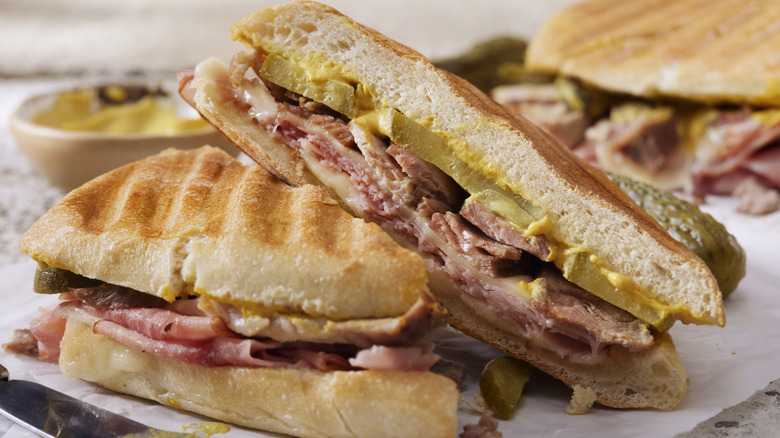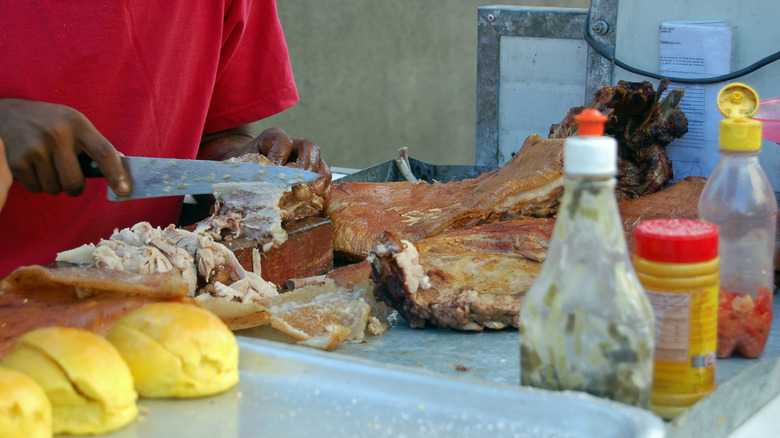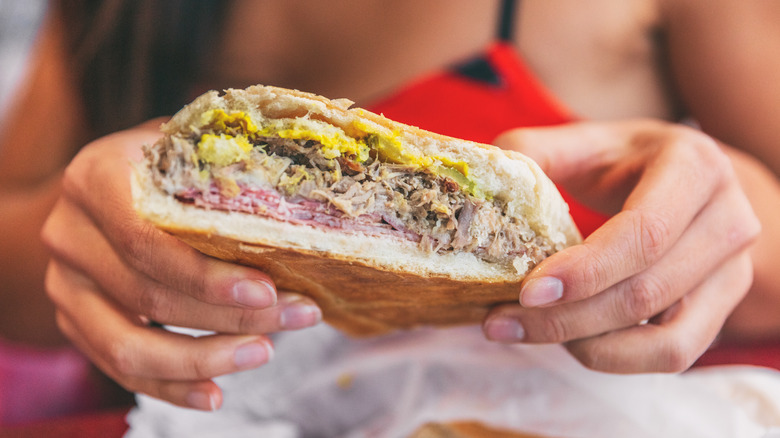How The Cuban Sandwich Became A Tampa Staple
When you think of where you can get a great Cuban sandwich loaded with perfect proportions of tender pork, savory sliced meats, melted Swiss cheese, tangy yellow mustard, and sour pickles, Miami certainly comes to mind, but what about Tampa, Florida? This sandwich — also called a Cubano — originated in Cuba in the late 1800s, but it became what it is today in Tampa, Florida.
In Cuba, the dish evolved from a mixto sandwich, which combined different types of meats and cheeses. Because it used imported ingredients from the United States and was popular with American tourists, it came to reflect a new era of trade and travel following hundreds of years of Spanish colonial rule. Around the same time, a wave of Cubans moved to the Tampa area seeking work in cigar and sugar factories in Ybor City (a neighborhood in Tampa), and they brought this new sandwich with them. It became a go-to for hungry workers in need of a filling lunch.
The dish has been a mainstay since. La Segunda Bakery in Ybor City has been baking up quintessential Cuban sandwich bread called pan de agua since 1915, and you can still order a Cuban sandwich there to this day. Another Tampa institution — Columbia Restaurant — has used the same recipe since 1915, and its Cubano continues to be served on bread from La Segunda Bakery. It wasn't until the mid-1900s when many fled Cuba for Miami that the Cuban sandwich took hold there too.
The Tampa Cubano versus the Miami Cubano
There really is not any debate about what a Cuban sandwich must include — roasted pork, sliced ham, pickles, Swiss cheese, and mustard — but there is some contention around any additions beyond that. The key difference between a Tampa and Miami Cubano is that the Tampa version (which did come first) has salami. This likely came from the influence of the significant Italian immigrant community in the area, and there are even some records of similar sandwiches made in Cuba around the 1950s using salami too.
The Miami take sometimes leaves off the pickles and adds lettuce and tomatoes — though most popular versions — including one of the most iconic from Versailles Restaurant — have no other veggies besides the fermented cukes. The two cities also use distinct styles of bread. Tampa's tends to be a crustier, homemade style of pan de agua — while the Miami kind leans smoother and softer. One thing that Miami can definitely claim is the added step of pressing the sandwich until thin and crisp. Though this is certainly the norm now, Tampa restaurants also often offer the sandwich cold.
Recreating a Tampa-style Cuban sandwich at home
For a Tampa-style Cubano, the salami is obviously a must, and Genoa salami (not salumi) is preferred. It brings a soft and bouncy texture and rich and tangy flavor that contrasts nicely with the firmer, smokier, sweeter ham. The secret behind the unique taste of the roasted pork is a mojo marinade that includes ingredients like cumin, garlic, sour oranges, and olive oil. At La Segunda Bakery, the roasted pork is fall-apart tender and shredded — whereas Columbia Restaurant's recipe relies on very thinly sliced pork loin instead.
If you can't get your hands on real-deal pan de agua made with lard, go for similar styles from Latin American bakeries or a softer French or Italian loaf. As for the assembly of a melty Cuban sandwich recipe, everyone has their own preferences on how much of each ingredient should be on the sandwich, how everything should be layered with the mustard, pickles, and cheese, and the way the sandwich is cut. The main thing is that it should not be overloaded since most of the ingredients are quite rich. You want a little bit of everything captured in freshly made bread.
To finish it, slick some butter on the top, toast it in a panini press or a pan with some sort of weight on top, or just eat it cold! Pair your Cubano with a Cuban coffee and a warm guava-filled pastry for dessert, and you really can't go wrong.



